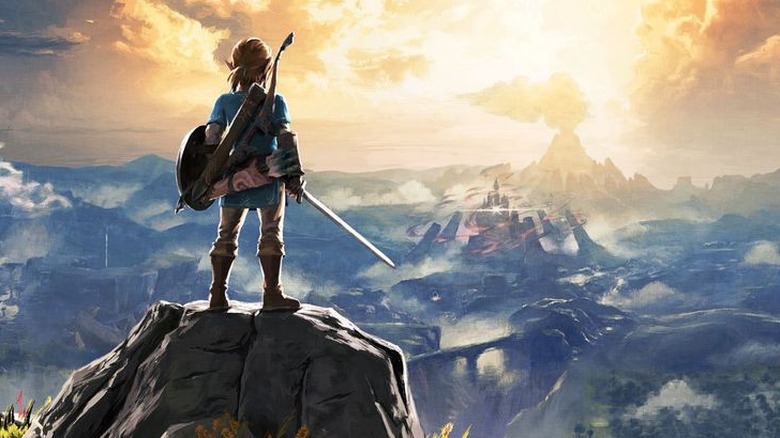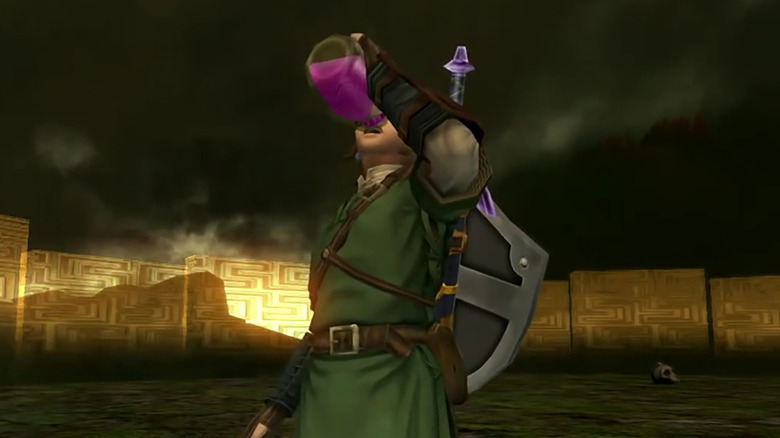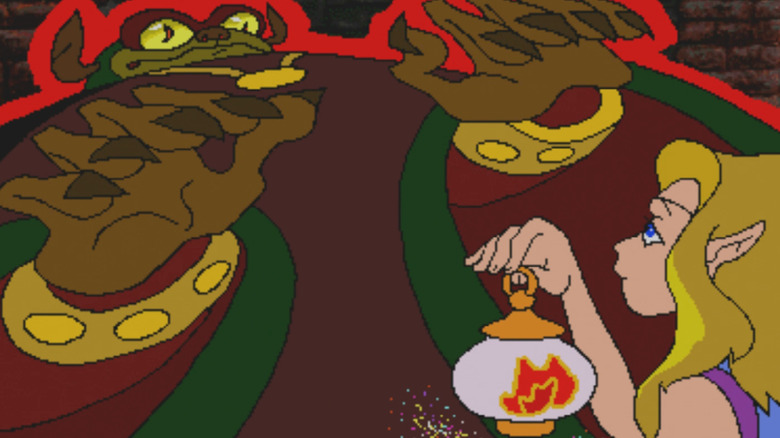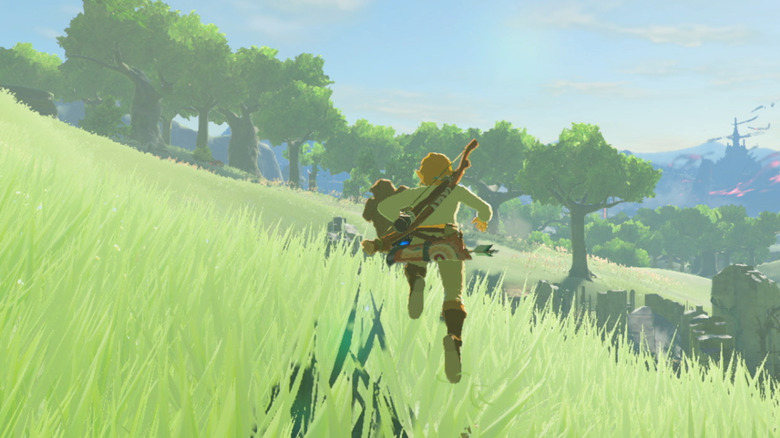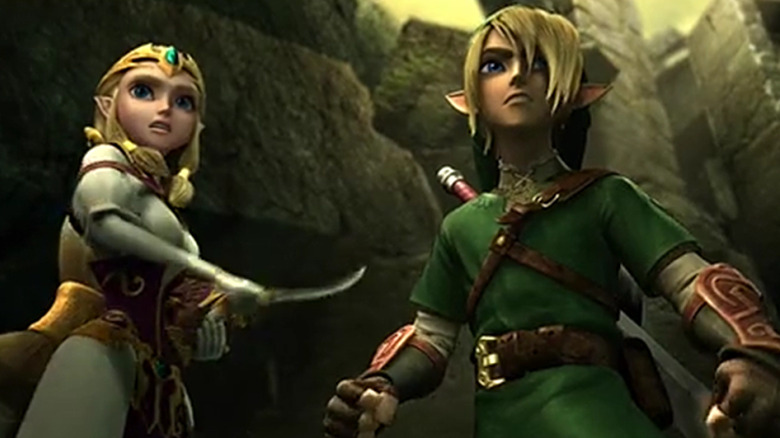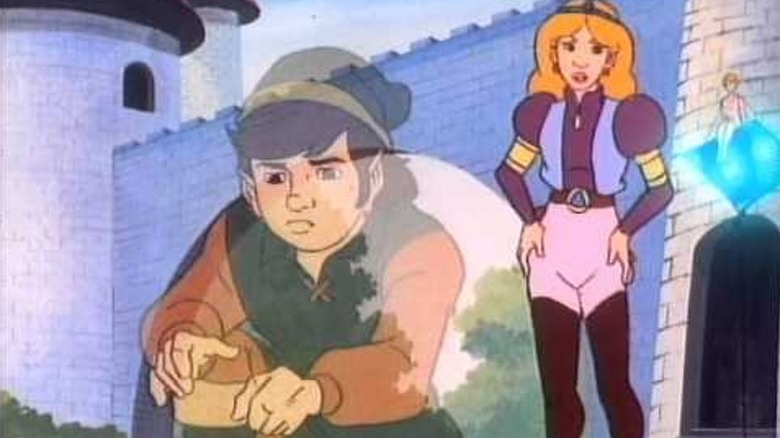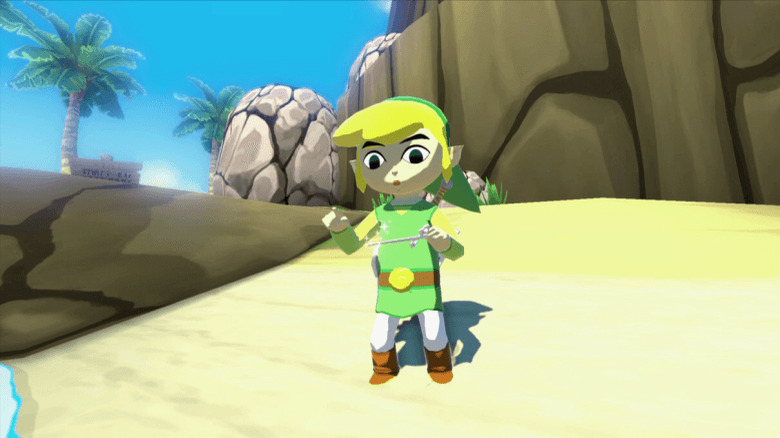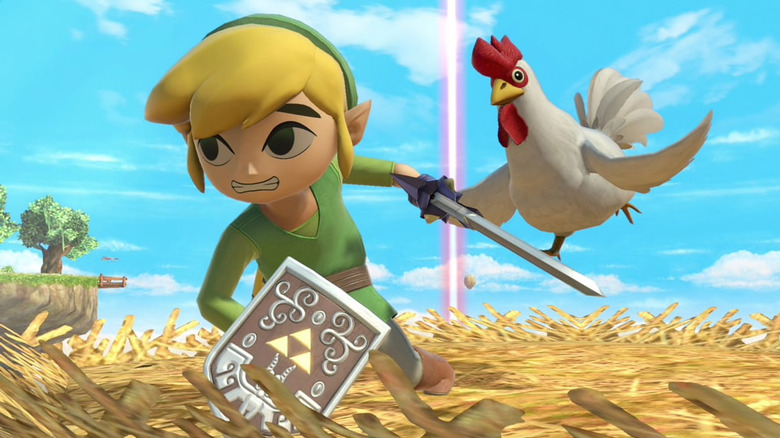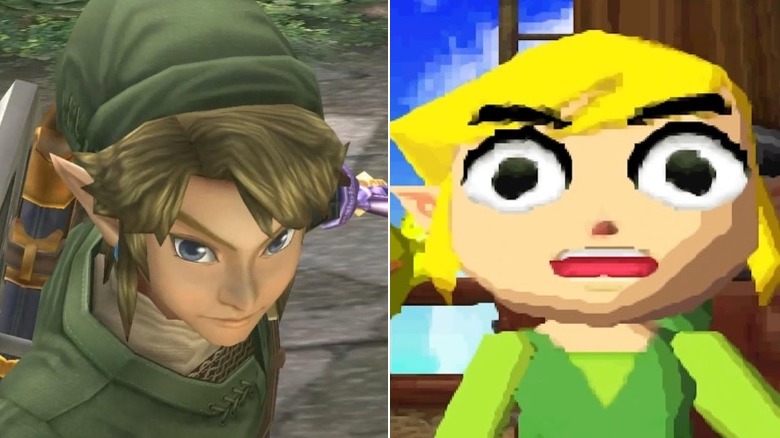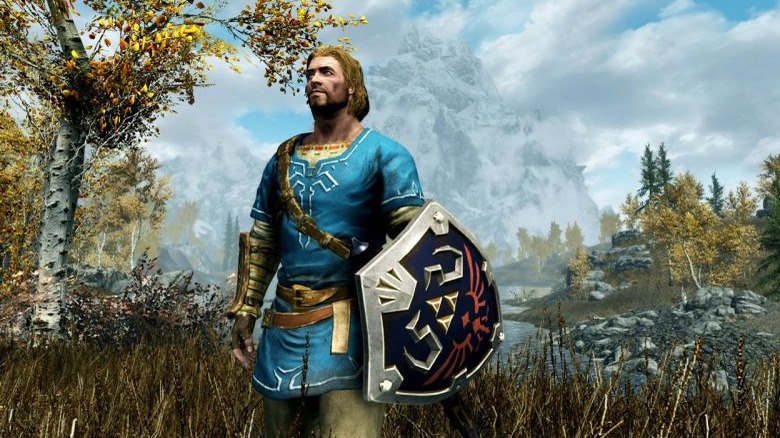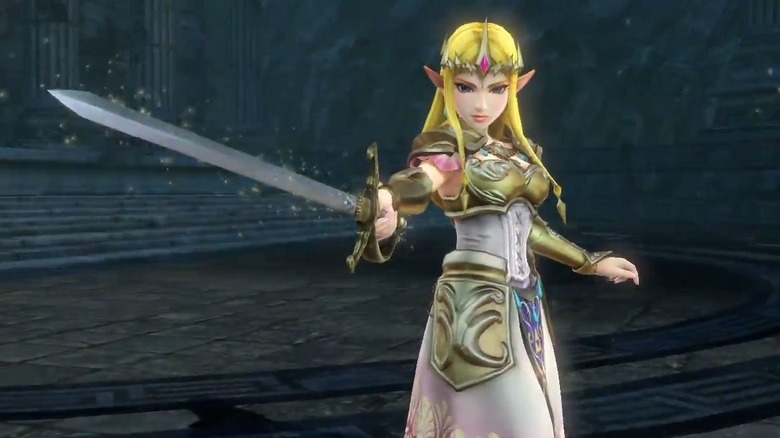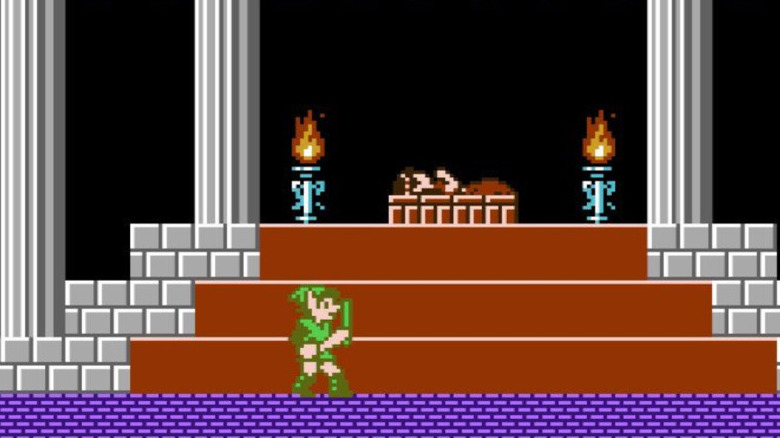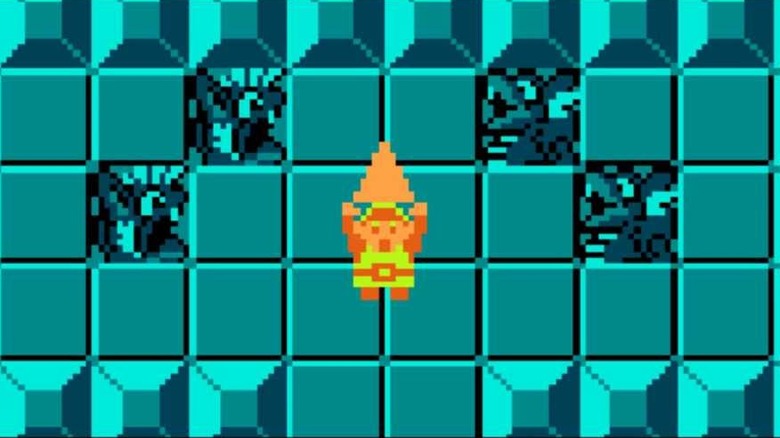Things Only True Zelda Fans Understand
Few franchises command the kind of love and attention to detail from fans as The Legend of Zelda. Since the release of the first game in the series in 1986, the story of Link and the titular princess has only expanded with time (and occasional time travel). The Legend of Zelda has inspired everything from fan films to fan-made games that explore different corners of this magical world.
With that kind of history, the series is bound to have more than a few idiosyncrasies that only folks who really love the series would pick up on. The game series itself definitely has interesting quirks and secrets, and sometimes the franchise has broken out into some other forms of media — in very odd ways. In other words, there are simply things about The Legend of Zelda franchise that only true fans would understand. Let's all put on our tunics and pointy caps and take a look at them.
Drinking a potion just to get the beeping to stop
One of the hallmarks of the Legend of Zelda series is that Link's hit points are illustrated by a series of hearts on the screen, which eventually dwindle down when the hero takes damage, until he's dead. Many of the games in the series also have another element to Link's hit points, which gamers may hear in their sleep at this point: when Link's health gets too low, a beeping sound will begin, signifying that the hero is near death.
In essence, you're already in a tight spot in a dungeon and now an alarm is going off. Or worse, you've gotten away from the danger but haven't replenished your health, so what should be a quiet walk in the Hyrulian countryside is now accompanied by a shrill sound effect. Either one of these scenarios will have even the most focused gamer driven to madness and reaching for the nearest potion or fairy to heal Link, just to silence the noise. By then, it's too late, and the earworm will have taken over. Face it: you're hearing it in your head right now.
The awful hilarity of the Philips CD-i games
The Phillips CD-i was a short-lived and overpriced disc-based console released in 1991. Possibly the most memorable thing about the ill-fated system was that Phillips had negotiated deals with Nintendo to use some of their characters for CD-i games. This is how we got a one-two punch of awfulness like Zelda: The Wand of Gamelon and Zelda: The Faces of Evil. While it's cool to note that these games first gave us Zelda herself as a playable character, that's where all of the innovation and fun ends. These titles were essentially rushed to market; the resulting games were bogged down by horrible gameplay and some of the ugliest (and awkwardly hilarious) cutscenes in the history of video games. Not even the most dedicated of Legend of Zelda fans would view these games as anything more than embarrassing novelties.
In the years since, these awful games have found a bizarre form of second life as a meme, with people chopping up the footage to use in parody videos. Even more impressive, an enterprising fan by the handle of C4DNerd animated a fake trailer for an imagined HD re-release of the CD-i games.
Making Link jump in Breath of the Wild
Link may be a heck of a fighter, but one thing he's not is a gymnast. Aside from Zelda 2, players pretty much couldn't make Link jump in any of the main series entries for the longest time. Even when the series made the "jump" to 3D with Ocarina of Time, Link still only hopped when the game wanted him to, not when the players did. According to author Chris Kohler, this was likely done by Nintendo to help the franchise stand on its own. As Kohler speculates, "Originally, Nintendo removed player-controlled jumping from Ocarina of Time so that the game ... would be distinguished from Mario. If Link could jump, wouldn't they do all sorts of jumping puzzles in the game? Then it would have felt like Mario, not Zelda."
So it was exciting when Breath of the Wild gave players the means to traverse the massive open world of the game with the added ability to jump. Considering the medium's rich history of platforming games, jumping is such a simple action that many gamers likely take for granted. For longtime fans, however, it was like being handed the keys to a whole new kingdom.
Sadness for the movie that never was
Once upon a time, we nearly got an animated Legend of Zelda film from Imagi Animation Studios, the folks behind 2007's TMNT animated movie. TMNT showcased plenty of style and flashy action sequences, which suggests that Imagi might have at least given us some pretty interesting visuals to bring the series' lore to life. A short teaser, in which Link and Zelda fought off a horde of monsters, was created as a proof of concept so that Imagi could pitch a full feature film to Nintendo. Unfortunately, the pitch was turned down by Nintendo, and Imagi went on to make 2009's Astro Boy instead, which would sadly go on to be their final film as a studio.
Meanwhile, the full tantalizing teaser eventually made its way onto the internet, as well as a video showing off the animation process behind the short. Though it's very brief, it's clear that there was a lot of love and excitement for the source material. If nothing else, Link would have certainly come off better in this than in the 1980s cartoon series.
The embarrassment of the '80s cartoon
While Castlevania was turned into a well loved show on Netflix, animated Nintendo adaptations haven't always enjoyed that much success or praise. For proof, look no further that 1989's The Legend of Zelda cartoon.
First of all, the animation itself was pretty stiff, which was fairly common for cartoons at that time. The real issue came with the writing. While Zelda herself is presented as capable and kind, the greatest sin of this cartoon series might be it's characterization of Link. As Den of Geek put it, "I'm sure the writers were going for some kind of 'lovable scamp' vibe with him, but he really just came off as a whiny, obnoxious, barely competent creep." The "creep" part is definitely right, with Link constantly harassing Zelda for kisses and yelling the awful catch phrase of, "Well, excuse me, Princess!" at least once an episode.
Still, for many non-gamers of a certain age, this cartoon was likely their introduction to these characters and their world. There's a chance (however unlikely) that this series plays better for folks who aren't as familiar with the characters. For longtime fans, however, it was simply painful to watch.
The original backlash against Toon Link
Though The Legend of Zelda: The Wind Waker is a beloved entry in the franchise, the initial response to Link's cutesier, cel-shaded design wasn't very kind. Petitions were started by unhappy fans to get a different game made altogether. People were genuinely angry over what they perceived as Nintendo's intent to be more childish. Though the game received rave reviews, a lot of this fan backlash is what led to Nintendo canceling a Wind Waker sequel on the Wii, opting to make the more serious Twilight Princess instead. Even now, there are still people who hate the "Toon Link" design.
Even the series' creator, the great Shigeru Miyamoto, confessed that he understood the look wasn't universally accepted. However, he felt that it was the best way to show that this Link was at a very different age and mindset than the one we're all familiar with. Miyamoto said, "I'll admit it took courage to use this more cartoon design ... As Link is a young boy rather than an adult, he was completely reinvented with a more streamlined look... So yes, I know that there are plenty of people who hate his cartoon version."
Chickens can't be killed; they only become more powerful
Okay, as real Legend of Zelda fans know, they're not really called chickens. In the world of the games, these little clucking creeps are called cuccos. But it's just funnier to think of Link being besieged by a flock of murderous chickens. That's exactly what will happen in many of the games if Link is foolish enough to keep trying to harm a defenseless cucco: the little bird will be unharmed, but he will keep squawking until a terrifying swarm descend on Link.
While some of the games in the series allowed Link to snag a cucco and use them to glide to safety, The Legend of Zelda: Breath of the Wild finally seized on the fact that these seemingly invincible birds are a force to be reckoned with. Holding a cucco while an enemy attacks will register that enemy as the cucco's attacker, sending the swarm of cuccos after them instead. While Zelda fans have always known the dangers of cucco attacks, Breath of the Wild finally weaponized the winged menaces.
The wacky timeline
To put it simply and in the most scientific of terms, the timeline of The Legend of Zelda is totally whackadoo bonkers. As our very own Christopher Gates put it, "The hero of every game is named Link and the princess is always named Zelda, but they're not always the same Link and Zelda ... Every time there's a big time jump, it's a new Link and Zelda on the scene." Got that? Maybe not, but Legend of Zelda fans have kind of made it their mission to suss out where and when each game takes place in the grand scheme of the series.
Luckily, Nintendo gave us Hyrule Historia, a book containing the official timeline (or timelines) of the series. It's here that we learned the timeline of the series is actually three separate ones, with continuities that branch off into a cycle of death and reincarnation following a decisive battle between Link and series antagonist Ganondorf. Naturally, even these intricate timelines have a few outliers, with a few of the games' events contradicting one another or featuring design aesthetics that seem to be at odds. It's confusing, but it's something that the series' fans genuinely love.
Link is still a big deal in Tamriel
Fans of The Elder Scrolls and The Legend of Zelda franchises were treated to a bit of crossover fun when The Elder Scrolls 5: Skyrim was ported to the Nintendo Switch. Players could find and equip some of Link's best gear from the series, including his tunic from Breath of the Wild and the legendary Master Sword. Additional items could be unlocked in Skyrim by using certain Legend of Zelda amiibo figures (which many fans had already obsessively collected, anyway).
Sure, this is basically a fun Easter egg for Nintendo fans, but it's also a neat little exercise for folks who like to develop their own head canon for these types of things. Having been reborn several times for countless adventures, who's to say that Link didn't find himself in Tamriel at some point? As long as he realizes that the faerie folk in this world aren't nearly as friendly as the type he's used to, then he should do just fine.
Wanting to play as Zelda
When asked why there wasn't an option to play as a female character in Breath of the Wild, series producer Eiji Aonuma said, "If we're going to have a female protagonist, it's simpler to have Princess Zelda as the main character ... [but] if we have Princess Zelda as the main character who fights, then what is Link going to do?"
That's some slightly reductive reasoning, considering the fact that fans have been clamoring for the opportunity to play as Zelda in a main series entry for quite some time. We've gotten smaller opportunities to do so, in games like Hyrule Warriors, Super Smash Bros. Ultimate, and (SIGH) the Phillips CD-i games, but it would be great to play as Zelda protecting her own kingdom for once.
Considering Zelda's status by the end of Breath of the Wild, there's a chance we may get our wish sometime soon. While Aonuma has also been somewhat cagey about whether or not we can expect to play as Zelda in the sequel to Breath of the Wild, even the slight tease is exciting for many fans.
The divisive Adventure of Link
Ever since its release in 1987, the debate has continued to rage: is Zelda 2: The Adventure of Link an underrated classic or a total betrayal?
Honestly, the answer may be a bit of both. The Adventure of Link differentiated itself from its predecessor (which, keep in mind, only came out the year before) almost immediately, switching from a top-down view to a side-scrolling presentation. Not only that, but it was gruelingly difficult and featured some truly embarrassing translations, including the gem: "I AM ERROR." Even Shigeru Miyamoto thinks it's the closest he's ever come to making a bad game.
Still, there are fans who still hold this game in high regard, insisting that folks should give it a second chance. GamesRadar called it the "most innovative" game of the series for all of the elements that it introduced to the Zelda formula. This may not be something that fans ever completely agree on, but at the very least, The Adventure of Link is going to be talked about for as long as the series has its followers.
The excitement of the Second Quest
In an era when New Game+ is more or less a given aspect of the medium, it's hard to remember a time when that was something that wasn't always guaranteed. In fact, when the original Legend of Zelda dropped, many fans were likely amazed to find that there was a whole new journey waiting for them after they rescued Zelda. This new challenge, also known as the Second Quest, rose from a mistake from game designer Takashi Tezuka, who realized he'd only used half of the game's memory when creating its dungeons. Therefore, he decided to remix the dungeons and throw in some extra baddies for players to discover after their first play through.
This tradition was continued in Zelda 2, with the added benefit that Link kept all of his gear from the first playthrough, a design that has been echoed by many of today's New Game+ modes. These days, it's just second nature for longtime Zelda fans to expect more game for their buck, but that feeling can be traced back to that exhilarating first game and its surprise second half.

